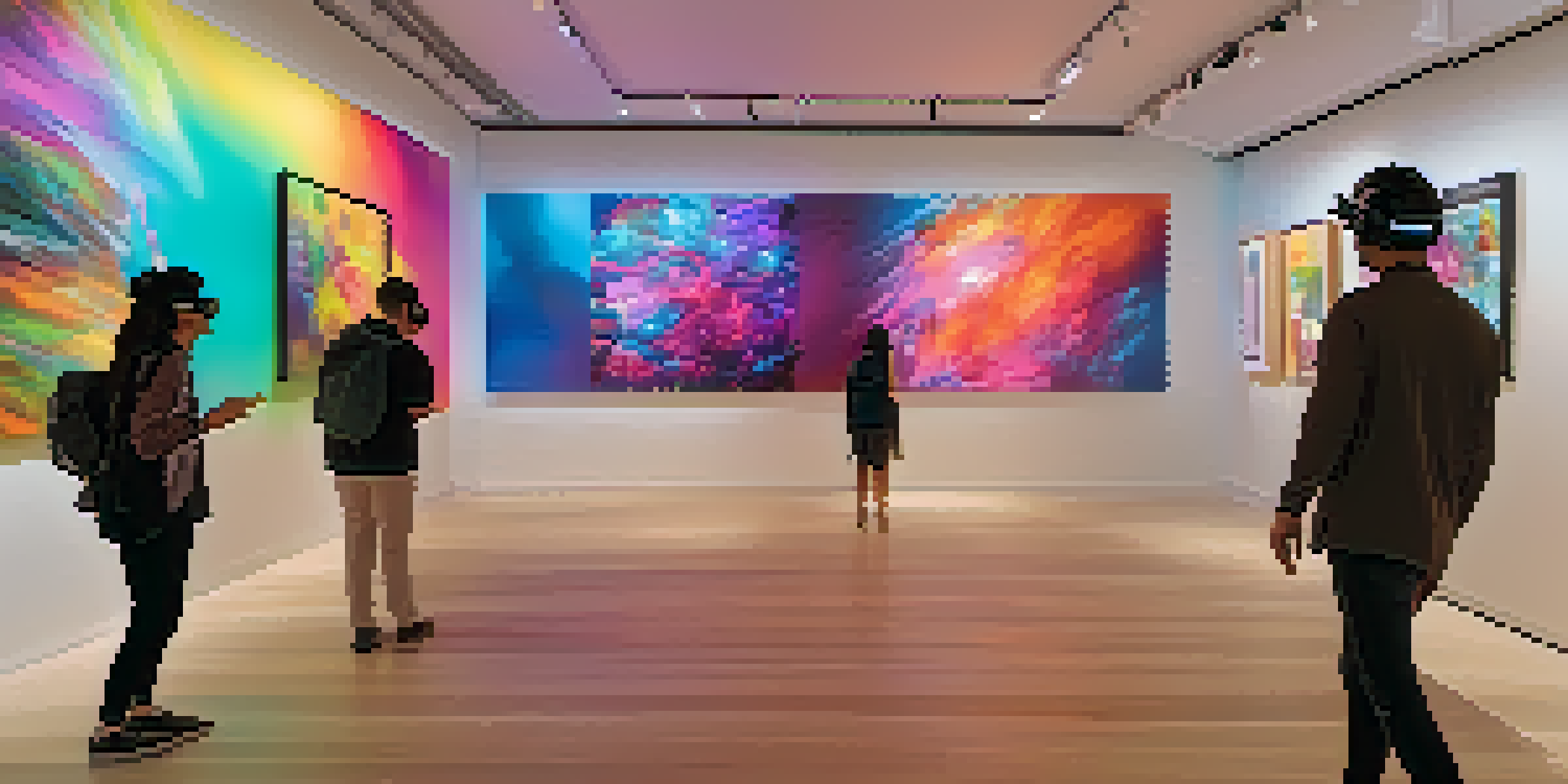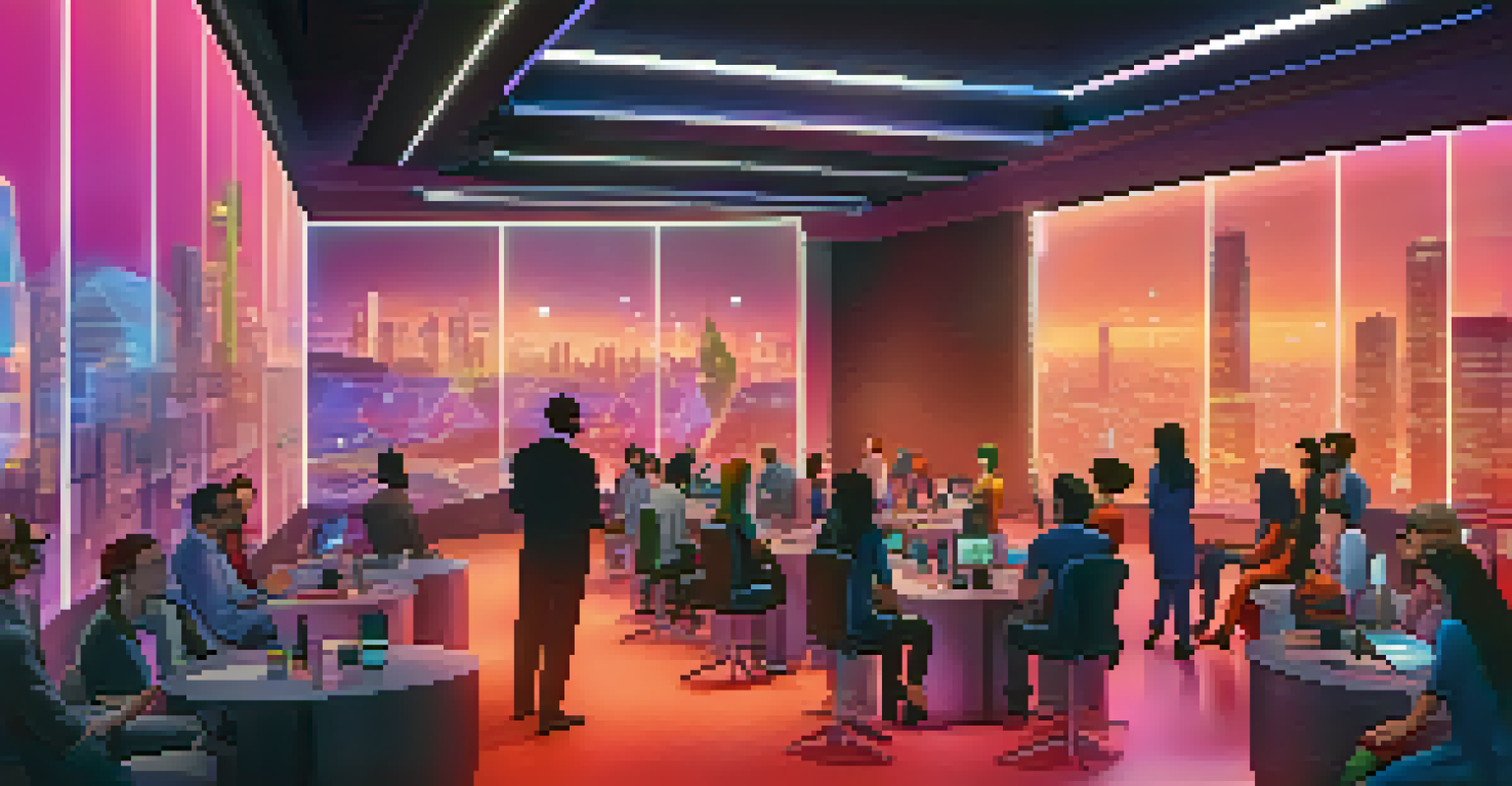The Intersection of Virtual Reality and NFTs in Digital Spaces

Understanding Virtual Reality and Its Impact
Virtual reality (VR) immerses users in simulated environments, creating experiences that feel incredibly real. Imagine stepping into a digital landscape where you can interact with others, manipulate objects, and explore new worlds—this is the magic of VR. As technology advances, VR is becoming more accessible, allowing more people to experience its benefits, from gaming to education and beyond.
Virtual reality is the first technology that lets you feel like you're somewhere else, and NFTs are the keys to owning a piece of that experience.
The immersive nature of VR offers unique opportunities for storytelling and engagement. For instance, brands can create virtual showrooms where customers can 'walk' through and interact with products before making a purchase. This not only enhances the shopping experience but also builds a stronger connection between the consumer and the brand.
Moreover, VR can transcend geographical limitations, bringing people together from different parts of the world. Consider a virtual conference where attendees can network in a 3D space, participate in interactive panels, and experience a sense of presence that traditional video calls simply can't replicate.
What Are NFTs and Why Do They Matter?
Non-fungible tokens (NFTs) are unique digital assets verified using blockchain technology. Unlike cryptocurrencies like Bitcoin, which are interchangeable, each NFT has distinct characteristics that make it one-of-a-kind. This uniqueness is why NFTs have surged in popularity, particularly in the realms of art, music, and gaming.

NFTs empower creators by providing a way to monetize their digital works. For example, an artist can sell their digital paintings as NFTs, ensuring that their work is not only recognized but also compensated fairly. This shift is democratizing access to art and creativity, allowing anyone to invest in and collect unique pieces.
VR Enhances Digital Experiences
Virtual reality creates immersive environments that offer unique storytelling opportunities and enhance user engagement across various fields.
Additionally, NFTs introduce the concept of ownership in the digital realm. When you purchase an NFT, you are buying a verified claim to that specific digital item, whether it's a piece of art, a music track, or even virtual real estate. This ownership aspect is crucial as it opens up new avenues for authenticity and value in digital spaces.
The Synergy of VR and NFTs: A New Frontier
Combining virtual reality and NFTs creates a powerful synergy that transforms digital experiences. Imagine attending a virtual art gallery where every piece is an NFT, allowing you to admire, purchase, and even interact with the artwork in real-time. This immersive engagement adds layers of value and excitement to the concept of collecting art.
The future of art is not only about the artwork itself but also about the experience and connection we have with it, especially in the digital realm.
In the gaming world, NFTs can represent unique in-game items, characters, or collectibles that players can trade or sell. Consider a scenario where you find a rare sword in a VR game; owning that sword as an NFT means you can showcase it in your virtual space, trade it with others, or even sell it for real-world currency. This not only enhances gameplay but also introduces real economic incentives for players.
Moreover, this intersection fosters unique communities around shared interests. Enthusiasts can gather in virtual spaces to celebrate their favorite NFTs, whether it's through exhibitions, concerts, or social events, creating a sense of belonging and collaboration among users.
The Role of Marketplaces in VR and NFT Integration
Marketplaces play a crucial role in the ecosystem of VR and NFTs. Platforms like Decentraland or Cryptovoxels allow users to buy, sell, and trade virtual real estate and NFTs, making it easier to navigate this new digital economy. As these marketplaces grow, they provide a centralized hub for creators and consumers to connect.
These platforms often feature user-friendly interfaces that simplify the process of purchasing and trading NFTs. For instance, a user can easily browse virtual galleries, discover unique digital art, and make purchases using cryptocurrency. This accessibility is essential for attracting a broader audience and enhancing user engagement.
NFTs Empower Digital Creators
Non-fungible tokens provide a unique way for artists and creators to monetize their digital works and establish ownership in the digital realm.
Furthermore, marketplaces are evolving to include social features that enhance the community experience. Users can interact with each other, attend virtual events, and showcase their collections, fostering a vibrant ecosystem that thrives on collaboration and creativity.
Challenges Facing VR and NFT Integration
Despite the exciting possibilities, the integration of VR and NFTs is not without its challenges. One major concern is the environmental impact of blockchain technology, particularly regarding energy consumption. As more NFTs are minted and traded, the carbon footprint can become significant, prompting a call for more sustainable practices.
Another challenge is the volatility of the NFT market. Prices for NFTs can fluctuate wildly, making it difficult for creators and collectors to navigate. This unpredictability might deter potential investors or artists who are hesitant about entering a market where value can change overnight.
Lastly, issues around copyright and ownership can complicate the landscape. As digital content is easily shared and replicated, ensuring that creators maintain control over their work is crucial. Clear regulations and guidelines are needed to protect both creators and collectors in this evolving digital space.
Future Trends in Virtual Reality and NFTs
As technology continues to advance, we can expect to see even more innovative uses of VR and NFTs. For instance, the development of mixed reality experiences could blend the physical and digital worlds, allowing users to interact with NFTs in real-life settings. Imagine seeing a digital sculpture displayed in your living room through augmented reality—this could soon be a reality.
Additionally, as VR hardware becomes more affordable and accessible, more users will be able to participate in these immersive experiences. This expansion could lead to a surge in demand for virtual spaces and NFTs, driving further innovation in both fields. Creators will have even more opportunities to experiment and push the boundaries of what's possible.
Challenges of VR and NFTs
The integration of VR and NFTs faces challenges such as environmental concerns, market volatility, and issues around copyright and ownership.
Moreover, the integration of artificial intelligence (AI) into VR and NFT platforms could enhance personalization. AI could analyze user preferences to recommend specific NFTs or virtual experiences, creating a tailored journey for each individual. This level of customization will likely increase user engagement and satisfaction.
Conclusion: Embracing the Digital Revolution
The intersection of virtual reality and NFTs represents a significant shift in the way we experience and interact with digital content. By combining immersive environments with unique digital assets, we're paving the way for new forms of creativity, ownership, and community engagement. This digital revolution is not just a trend; it's transforming how we perceive value in digital spaces.
As we navigate this evolving landscape, it's essential to remain open to new ideas and possibilities. Whether you're a creator, collector, or simply curious about these technologies, embracing this change can lead to exciting opportunities and experiences. The future of VR and NFTs is bright, and it’s up to us to shape it.

In conclusion, staying informed and engaged with these developments will empower us to fully enjoy the benefits they bring. So, dive in, explore the virtual galleries, and don't hesitate to collect those unique NFTs—after all, the digital frontier is just beginning to unfold.